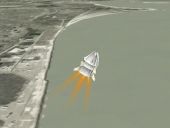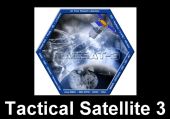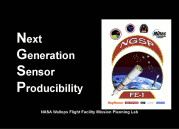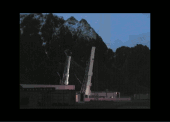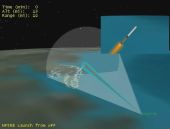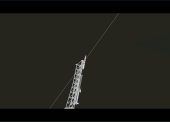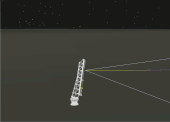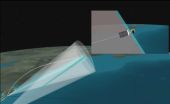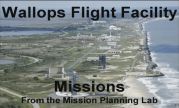
Mission Planning Lab
MPL Success Stories
The following NASA missions have been successfully supported by the Mission Planning Lab.
WFF Photometric and miniATM Payload Flight
The NASA WFF Photometric and miniaturized Airborne Topographic Mapper (miniATM) Payloads were flown on an L-3 Unmanned Systems Viking 300 on September 11, 2011. The miniATM is a Light Detection and Ranging system onboard the Common Payload Integration Package (CPIP) which is designed to complement the Wallops ATM used for Ice Mapping. The Photometric Payload provides an alternative approach to the WFF miniATM system by capturing image data via two cameras in 'stereo' configuration. The aircraft attitude data is received directly from the aircraft autopilot, which will enable real-time visualization of the aircraft and instrumentation.
For more information on the Photometric and miniATM Payloads, please contact Michael Hitch, 757-824-1522.
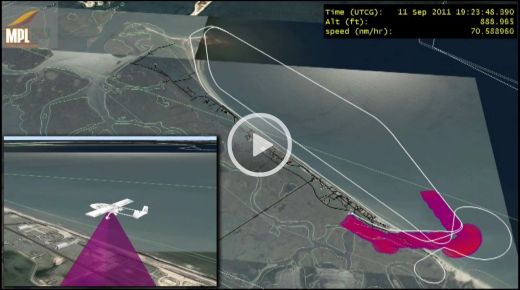
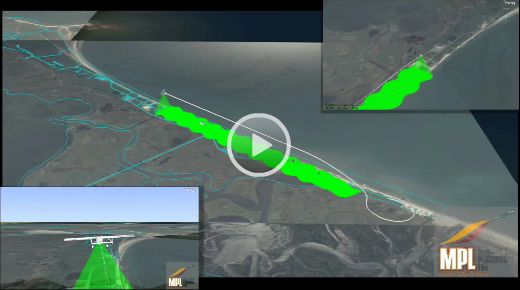
SubTEC-III/Bull
The Autonomous Flight Safety System (AFSS) is a technological development project of NASA Goddard Space Flight Center's Wallops Flight Facility and NASA's Kennedy Space Center which will enable termination of errant launch vehicles via onboard systems rather than by human action and the massive ground infrastructure in use today. AFSS inputs vehicle position and dynamics from Global Positioning Satellites (GPS) and Inertial sensors and uses mission rules based software to determine if the flight is proceeding safely and, if not, initiates action to terminate it. SubTEC-III/Bull 41.082 is the third developmental/test flight.
Although AFSS requires neither telemetry nor command, it is desirable that the status and actions taken by AFSS are relayed to the ground, and under some conditions, the flight termination function can be shared by ground based command. LCT2 (Low Cost TDRSS Transceiver), a software defined radio designed and built at Wallops, will provide this capability even as the vehicle proceeds out of range of ground based facilities. As a transmitter, LCT2 has been flown on a number of launches but on SubTEC-III/Bull 41.082 it will, for the first time, be configured to both transmit data and receive commands via Tracking and Data Relay Satellite System (TDRSS).
For more information on AFSS or LCT2, please contact Barton Bull, 757-824-1893.
MLAS
NASA's next generation of spacecraft will have the safest-ever astronaut escape system, a modern-day version of the reliable Apollo system. Like Apollo, the Orion launch abort system will swiftly propel the crew capsule away from the nose of the Ares I rocket and out of harm's way in case of an emergency on the launch pad or during ascent to orbit. The alternate system, called Max Launch Abort System, or MLAS, was successfully tested in a simulated pad abort test at NASA's Wallops Flight Facility, Wallops Island, Virginia on July 8, 2009.
TacSat-3
TacSat-3 was launched from Wallops Island, VA on May 19, 2009. TacSat-3 features three revolutionary trials: the Raytheon Company-built Advanced Responsive Tactically Effective Military Imaging Spectrometer hyperspectral imager, the Office of Naval Research's Satellite Communications Package, and the Air Force Research Laboratory's Space Avionics Experiment.
SubTec-II/Smith
The Sub-TEC II (Suborbital Technology Experiment Carrier) technology demonstration mission was launched from Wallops Island, VA on July 14, 2008 aboard a Terrier Mk70 Improved-Orion Sounding Rocket. It included the NASA/Wallops Beamformer system, KSC Command and Telemetry Processor and Rf Health Node, and multiple NSROC (NASA Sounding Rockets Operations Contract) systems.
NGSP/LeClair
A Black Brant XI was launched from Wallops Island, VA on June 26, 2008. The purpose of the mission was to enable new sensor technology and improve mission assurance of sensor flight experiments. This exercise, identified as the Next Generation Sensor Producibility flight test (NGSP), successfully demonstrated the performance of emerging sensor technologies, materials, and designs. During the exercise, the sounding rocket carried a payload consisting of multiple optical and infrared sensors, along with various objects. Upon reaching the desired altitude in the exo-atmosphere, the objects were ejected to present a viewing scene for the sensors under test.
Kletzing
Two Black Brant XII Sounding Rockets were launched from Andoya Rocket Range, Norway on December 10, 2007 as part of the Twin Rockets to Investigate Cusp Electrodynamics (TRICE) mission. Sounding rockets were the only means of fulfilling the requirements of the TRICE mission. To study reconnection of magnetic fields, this unique mission required two identically instrumented rockets to fly near the same magnetic field line, separated in time by four minutes, and in altitude by 750 km.
NFIRE
An Air Force Minotaur 1 rocket was successfully launched at 2:48 AM EDT April 24, 2007 from Wallops Flight Facility. The four-stage rocket carried the Defense Department's Missile Defense Agency's (MDA) Near Field Infrared Experiment (NFIRE) satellite.
Craven
The HEX 2 mission was successfully launched from Poker Flat Research Range in Alaska on February 14, 2007 aboard four sounding rockets: three Terrier-Orions and a Black Brant X. The fundamental scientific objective for the HEX 2 mission was, for the first time, to measure all terms in the atmospheric mass continuity equation, using a combination of rockets and various ground-based diagnostics facilities.
Lessard
The ROPA (Rocket Observations of Pulsating Aurora) mission was successfully launched from Poker Flat Research Range, Alaska on February 12, 2007 aboard a Black Brant XII Sounding Rocket. The ROPA mission seeks to understand the response of the magnetosphere to the solar wind and the subsequent transfer of energy to the ionosphere during a pulsating aurora.
TacSat-2
TacSat-2 launched successfully at 7 AM EST on Saturday, Dec. 16, 2006. TacSat-2 was propelled into a circular orbit approximately 255 miles above the Earth by a Minotaur I launch vehicle. The satellite, housed in a shroud atop the rocket, was released into space between 100,000 and 150,000 feet altitude, and shared the brief ride into the cosmos with NASA's GeneSat-1.
Reference
- Responsible NASA Official: Benjamin Cervantes
- Curator: Brandon Wright
- Last Updated: January 18, 2013


